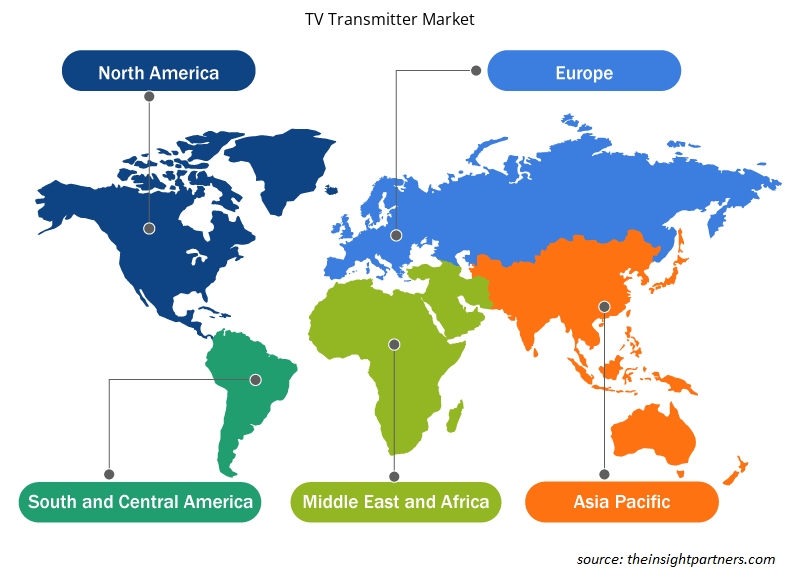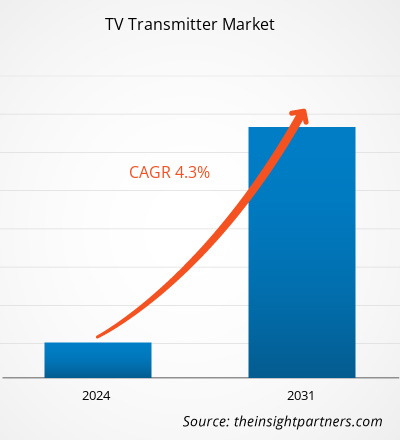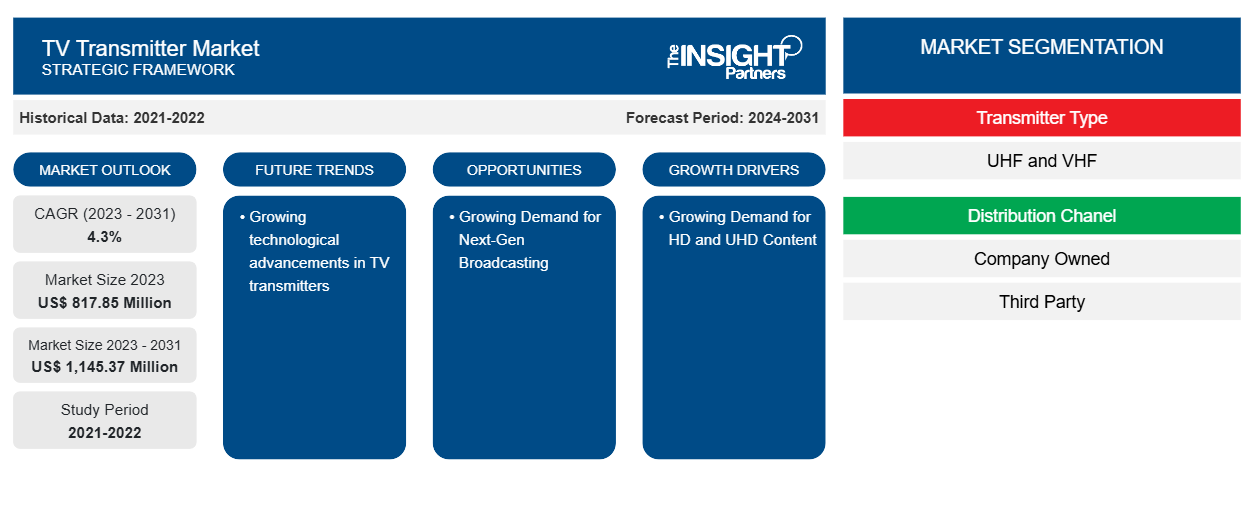من المتوقع أن يصل حجم سوق أجهزة إرسال التلفزيون إلى 1,145.37 مليون دولار أمريكي بحلول عام 2031 من 817.85 مليون دولار أمريكي في عام 2023. ومن المتوقع أن يسجل السوق معدل نمو سنوي مركب بنسبة 4.3٪ في الفترة 2023-2031. ومن المرجح أن يظل الطلب المتزايد على المحتوى عالي الدقة اتجاهًا رئيسيًا في سوق أجهزة إرسال التلفزيون.
تحليل سوق أجهزة الإرسال التلفزيونية
الطلب المتزايد على محتوى HD وUHD في جميع أنحاء العالم هو أحد العوامل الرئيسية التي تغذي نمو سوق أجهزة إرسال التلفزيون. بالإضافة إلى ذلك، تعمل الابتكارات المستمرة في قطاع الاتصالات والبث على دفع نمو سوق أجهزة إرسال التلفزيون. علاوة على ذلك، من المتوقع أن يعزز الطلب المتزايد على البث من الجيل التالي نمو السوق في الفترة المتوقعة. علاوة على ذلك، فإن التقدم التكنولوجي المتزايد في أجهزة إرسال التلفزيون يخلق فرصة لنمو سوق أجهزة إرسال التلفزيون في السنوات القادمة.
نظرة عامة على سوق أجهزة إرسال التلفزيون
جهاز إرسال التلفزيون هو جهاز كهربائي يصدر موجات راديو تحمل إشارة الفيديو التي تعرض صورة ديناميكية وإشارة الصوت المتزامنة معها. سيتم استقبالها بواسطة جهاز استقبال تلفزيوني، والذي سيعرض الصورة على الشاشة ويشغل الصوت المطابق. يقتصر تردد تشغيله على نطاقي التردد VHF وUHF ويتراوح خرج الطاقة من 5 وات إلى 10 كيلو وات. يتم استخدامه بشكل شائع في مجال البث التلفزيوني ، مثل محطات التلفزيون.
قم بتخصيص هذا التقرير ليناسب متطلباتك
ستحصل على تخصيص لأي تقرير - مجانًا - بما في ذلك أجزاء من هذا التقرير، أو تحليل على مستوى الدولة، وحزمة بيانات Excel، بالإضافة إلى الاستفادة من العروض والخصومات الرائعة للشركات الناشئة والجامعات
-
احصل على أهم اتجاهات السوق الرئيسية لهذا التقرير.ستتضمن هذه العينة المجانية تحليلاً للبيانات، بدءًا من اتجاهات السوق وحتى التقديرات والتوقعات.
محركات وفرص سوق أجهزة إرسال التلفزيون
الطلب المتزايد على المحتوى عالي الدقة والوضوح الفائق
يتزايد الطلب على المحتوى عالي الدقة (HD) وفائق الدقة (UHD) بين المستهلكين في جميع أنحاء العالم، وخاصة لأنه يوفر صوتًا وفيديو عالي الجودة. علاوة على ذلك، يتزايد استخدام منصات OTT في جميع أنحاء العالم جنبًا إلى جنب مع إصدارات المحتوى عالي الجودة. وبالتالي، فإن الطلب المتزايد على المحتوى عالي الجودة يغذي نمو سوق أجهزة الإرسال التلفزيونية.
النموالطلب على البث من الجيل التالي
يتضمن البث من الجيل التالي اعتماد معايير البث الرقمي، مع تبني مناطق مختلفة في جميع أنحاء العالم لمعايير محددة مثل ATSC 3.0 في الولايات المتحدة، وDVB-T2 في أوروبا، وISDB-Tb في أجزاء معينة من آسيا وأمريكا الجنوبية. تشمل الفوائد المترتبة على هذه المعايير تحسين جودة الصوت والفيديو، والاستخدام الأكثر فعالية للطيف المتاح، وإضافة ميزات تفاعلية جديدة. يجعل الانتقال إلى معايير البث الرقمي من السهل بث البرامج عالية الدقة (HD) وفائقة الدقة (UHD)، مما يمنح المشاهدين تجربة بصرية وصوتية أفضل بكثير ويزيد من استمتاعهم بالتلفزيون. وبالتالي، من المتوقع أن يخلق الطلب المتزايد على البث من الجيل التالي فرصة لنمو سوق أجهزة الإرسال التلفزيونية.
تقرير تحليل تجزئة سوق أجهزة إرسال التلفزيون
إن القطاعات الرئيسية التي ساهمت في اشتقاق تحليل سوق أجهزة إرسال التلفزيون هي نوع جهاز الإرسال وقناة التوزيع والتطبيق.
- بناءً على نوع جهاز الإرسال، ينقسم سوق أجهزة إرسال التلفزيون إلى UHF وVHF. احتل قطاع UHF حصة سوقية أكبر في عام 2023. ينقسم قطاع UHF إلى منخفض ومتوسط وعالي. وبالمثل، ينقسم قطاع VHF إلى منخفض ومتوسط.
- بحسب قناة التوزيع، تم تقسيم السوق إلى شركات مملوكة وأطراف ثالثة. احتلت شريحة الشركات المملوكة الحصة الأكبر من السوق في عام 2023.
- من حيث التطبيق، تم تقسيم السوق إلى محطات تلفزيونية صغيرة ومحطات تلفزيونية كبيرة. احتل قطاع محطات التلفزيون الكبيرة الحصة الأكبر من السوق في عام 2023.
تحليل حصة سوق أجهزة إرسال التلفزيون حسب المنطقة الجغرافية
ينقسم النطاق الجغرافي لتقرير سوق أجهزة إرسال التلفزيون بشكل أساسي إلى خمس مناطق: أمريكا الشمالية، ومنطقة آسيا والمحيط الهادئ، وأوروبا، والشرق الأوسط وأفريقيا، وأمريكا الجنوبية/أمريكا الجنوبية والوسطى.
من حيث الإيرادات، استحوذت منطقة آسيا والمحيط الهادئ على أكبر حصة في سوق أجهزة الإرسال التلفزيونية. وتنقسم السوق في هذه المنطقة إلى أستراليا والصين والهند وكوريا الجنوبية واليابان وبقية منطقة آسيا والمحيط الهادئ. ويعمل اللاعبون في السوق في المنطقة باستمرار على التقدم التكنولوجي في قطاع البث، وهو العامل الرئيسي الذي يغذي نمو سوق أجهزة الإرسال التلفزيونية في منطقة آسيا والمحيط الهادئ. وعلاوة على ذلك، تشهد المنطقة نموًا هائلاً في صناعة الإعلام والترفيه، مما يغذي نمو سوق أجهزة الإرسال التلفزيونية.
رؤى إقليمية حول سوق أجهزة إرسال التلفزيون
لقد قام المحللون في Insight Partners بشرح الاتجاهات والعوامل الإقليمية المؤثرة على سوق أجهزة إرسال التلفزيون طوال فترة التوقعات بشكل شامل. يناقش هذا القسم أيضًا قطاعات سوق أجهزة إرسال التلفزيون والجغرافيا في جميع أنحاء أمريكا الشمالية وأوروبا ومنطقة آسيا والمحيط الهادئ والشرق الأوسط وأفريقيا وأمريكا الجنوبية والوسطى.

- احصل على البيانات الإقليمية المحددة لسوق أجهزة إرسال التلفزيون
نطاق تقرير سوق أجهزة إرسال التلفزيون
| سمة التقرير | تفاصيل |
|---|---|
| حجم السوق في عام 2023 | 817.85 مليون دولار أمريكي |
| حجم السوق بحلول عام 2031 | 1,145.37 مليون دولار أمريكي |
| معدل النمو السنوي المركب العالمي (2023 - 2031) | 4.3% |
| البيانات التاريخية | 2021-2022 |
| فترة التنبؤ | 2024-2031 |
| القطاعات المغطاة |
حسب نوع المرسل
|
| المناطق والدول المغطاة |
أمريكا الشمالية
|
| قادة السوق وملفات تعريف الشركات الرئيسية |
|
كثافة اللاعبين في سوق أجهزة إرسال التلفزيون: فهم تأثيرها على ديناميكيات الأعمال
يشهد سوق أجهزة إرسال التلفزيون نموًا سريعًا، مدفوعًا بالطلب المتزايد من المستخدم النهائي بسبب عوامل مثل تفضيلات المستهلك المتطورة والتقدم التكنولوجي والوعي المتزايد بفوائد المنتج. ومع ارتفاع الطلب، تعمل الشركات على توسيع عروضها والابتكار لتلبية احتياجات المستهلكين والاستفادة من الاتجاهات الناشئة، مما يؤدي إلى زيادة نمو السوق.
تشير كثافة اللاعبين في السوق إلى توزيع الشركات أو المؤسسات العاملة في سوق أو صناعة معينة. وهي تشير إلى عدد المنافسين (اللاعبين في السوق) الموجودين في مساحة سوق معينة نسبة إلى حجمها أو قيمتها السوقية الإجمالية.
الشركات الرئيسية العاملة في سوق أجهزة إرسال التلفزيون هي:
- رودي وشوارتز
- شركة NEC
- مجموعة هيتاشي كوكوساي الكهربائية
- بيتسوا
- إيجاتيل
- بوابات جوية
إخلاء المسؤولية : الشركات المذكورة أعلاه ليست مرتبة بأي ترتيب معين.

- احصل على نظرة عامة على أهم اللاعبين الرئيسيين في سوق أجهزة إرسال التلفزيون
أخبار سوق أجهزة الإرسال التلفزيونية والتطورات الأخيرة
يتم تقييم سوق أجهزة إرسال التلفزيون من خلال جمع البيانات النوعية والكمية بعد البحث الأولي والثانوي، والذي يتضمن منشورات الشركات المهمة وبيانات الجمعيات وقواعد البيانات. فيما يلي قائمة بالتطورات في سوق اضطرابات الكلام واللغة والاستراتيجيات:
- أعلنت شركة ENENSYS Technologies، وهي شركة رائدة في تقديم حلول توصيل الوسائط، وشركة ELECTROLINK، وهي شركة إيطالية لتصنيع أجهزة إرسال التلفزيون، عن نجاحها في تسليم جميع أنظمة إرسال DVB-T/T2 العاملة في مناطق أبروتسو ولاتسيو وليغوريا إلى Rai Way، والمتعلقة بمشروع إعادة الزراعة في إيطاليا، والذي تم تكليفه من خلال مناقصة عامة. وقد أقامت ENENSYS وELECTROLINK شراكة خاصة لهذا المشروع، حيث تقدم كل شركة أفضل المكونات والخدمات الهندسية لتقديم نظام إرسال DVB-T/T2 الأكثر كفاءة وموثوقية وحداثة إلى Rai Way. (المصدر: ENENSYS Technologies، بيان صحفي، 2023)
- افتتحت قناة Hope Channel Central Philippines الاستوديو الجديد وموقع البث في مقر مؤتمر اتحاد الفلبين المركزي (CPUC) في مدينة سيبو بالفلبين. (المصدر: الأدفنتست، بيان صحفي، 2023)
تقرير سوق أجهزة إرسال التلفزيون والتغطية والنتائج المتوقعة
يوفر تقرير "حجم سوق أجهزة إرسال التلفزيون والتوقعات (2021-2031)" تحليلاً مفصلاً للسوق يغطي المجالات التالية:
- حجم السوق والتوقعات على المستويات العالمية والإقليمية والوطنية لجميع قطاعات السوق الرئيسية التي يغطيها النطاق
- ديناميكيات السوق مثل المحركات والقيود والفرص الرئيسية
- الاتجاهات المستقبلية الرئيسية
- تحليل مفصل لقوى PEST/Porter الخمس وSWOT
- تحليل السوق العالمي والإقليمي الذي يغطي اتجاهات السوق الرئيسية واللاعبين الرئيسيين واللوائح والتطورات الأخيرة في السوق
- تحليل المشهد الصناعي والمنافسة الذي يغطي تركيز السوق، وتحليل خريطة الحرارة، واللاعبين البارزين، والتطورات الأخيرة
- ملفات تعريف الشركة التفصيلية
- التحليل التاريخي (سنتان)، سنة الأساس، التوقعات (7 سنوات) مع معدل النمو السنوي المركب
- تحليل PEST و SWOT
- حجم السوق والقيمة / الحجم - عالمي، إقليمي، بلد
- الصناعة والمنافسة
- مجموعة بيانات إكسل
التقارير الحديثة
تقارير ذات صلة
شهادات العملاء
سبب الشراء
- اتخاذ قرارات مدروسة
- فهم ديناميكيات السوق
- تحليل المنافسة
- رؤى العملاء
- توقعات السوق
- تخفيف المخاطر
- التخطيط الاستراتيجي
- مبررات الاستثمار
- تحديد الأسواق الناشئة
- تحسين استراتيجيات التسويق
- تعزيز الكفاءة التشغيلية
- مواكبة التوجهات التنظيمية























 احصل على عينة مجانية ل - سوق أجهزة إرسال التلفزيون
احصل على عينة مجانية ل - سوق أجهزة إرسال التلفزيون